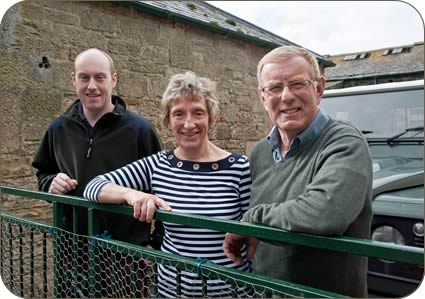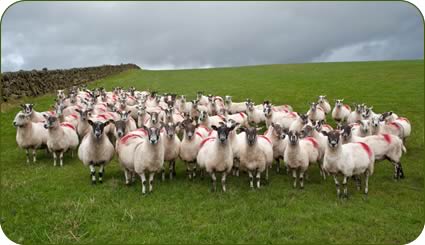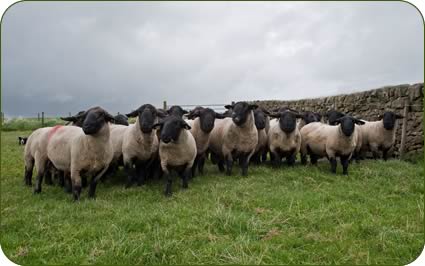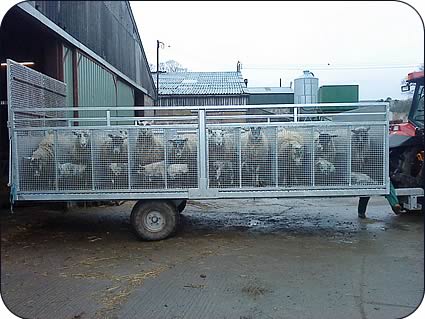Jennifer MacKenzie is an agricultural photo journalist with almost 30 year's experience. Operating from her base in Cumbria, Jennifer undertakes mainly industry-related freelance writing and photography.
Good Management is Key to Profit at Knockenjig
Until March 2009 David and Rosemary Dickie were milking up to 170 pedigree
Ayrshires at Knockenjig, but since selling the dairy herd they have focused
attention on their commercial sheep and started a small pedigree Beef Shorthorn
herd.
The 500 Mules were increased to 1,050 and the couple have adopted the same principles with their animal health strategy that they had when they milked cows - to maximise flock health and, in turn, maximise production and profitability.
Testament to the success of their noted Ayrshire herd was that the top price of 7,000gns paid at their dispersal sale for Knockenjig Moonshine 23 was the second highest price paid for an Ayrshire cow.
 |
| Vet Alistair Padkin, left of Solway Vets’ member practice Nithsdale Vets, Thornhill, with Rosemary and David Dickie |
Flock replacements are all bought-in, mainly as hoggs with lambs at foot sourced privately from one farm, with some ewe lambs bought through the ring at Dumfries mart.
A flock health plan and calendar paying particular attention to the bought-in sheep is drawn up annually with vet Alistair Padkin of Solway Vets’ member practice Nithsdale Vets and reviewed as the year progresses. David and Rosemary are meticulous with their lambing regime in which they have help from their daughter Catriona, two veterinary students and their employee Robert Sulivan.
“We have always practised prevention and vaccinated our stock which we believe is the most cost-effective way,” said David. “Any animal that dies is one too many.”
“Lambing time is our harvest - it’s a crop,” added Rosemary. “It’s
all about producing the most lambs possible for sale.”
 |
| A sheep health plan helps Rosemary and David Dickie produce the most lambs possible for sale from their flock of Scotch Mules |
The bought-in hoggs and any ewe lambs are isolated when purchased and given Dectomax and a drench to prevent sheep scab and worms. They also get a fluke treatment and are started on the Heptovac-P system. All the sheep on the farm are vaccinated against abortion with Toxovax and Cevac Chylamydia.
Ewes already on the farm are given one worming dose per year as they leave the lambing shed, for this Cydectin drench is used which helps to keep the system simple.
The ewes are flushed on silage aftermath before they are run with the ram at 40 ewes to each tup from October 31. The tups are out until mid December.
 |
| Commercial Suffolk shearling rams are isolated and treated for scab, fluke and worms after purchase before joining the flock. |
Commercial Suffolk shearling rams are bought mainly at Kelso and they are isolated and treated for scab, fluke and worms before joining the flock. There up to 28 rams are run at Knockenjig and they are expected to last three to four years.
The ewes are scanned in mid January generally achieving a 200% plus.
They are treated for lice at housing which begins at the end of January with up to 900 ewes able to be accommodated at one time.
Alistair said: “Because the wet climate necessitates housing the ewes for a length of time, lameness can be a problem caused by footrot and digital dermatitis. This can add greatly to the workload during the winter and is a constant annoyance to a stockman like David. One option is treating the sheep with Micotil at housing and this will be trialed with a group of ewes this year.”
When housed the ewes are fed haylage and a 16% protein concentrate, increasing to 18% as lambing approaches. Blood samples are taken from the twins and triplets in early march to gauge nutritional status and body codition scoring is carried out.
Lambing begins in the last week of March and the majority of ewes lamb during the first three weeks. Between scanning and leaving the lambing shed up to 10% of lambs can be lost with up to another 2% prior to marketing.
 |
| A custom built trailer with individual pens helps prevent stress on the ewes and lambs when turning out after lambing and mis-mothering is minimal |
Rosemary pays particular attention to the lambs for the first 24 hours after birth, ensuring they receive adequate colostrum within the first hour and any problem lambs are boosted with artificial colostrum. Twinning is attempted with all singles and most ewes leave the shed with twins. Hygiene is critical in the lambing shed and individual pens are cleaned and disinfected between every sheep. All lambs have their navels treated with iodine and are injected with Amoxypen LA to prevent joint ill.
Ewes and lambs are turned out as soon as the weather permits. A custom built trailer with individual pens from Tough Trailers at New Abbey helps prevent stress on the ewes and lambs and mis-mothering is minimal.
Pet lambs - there can be up to 50 - are put onto Shepherdess feeders.
This year the lambs were given a white drench against nematodirus at 4-5 weeks old. They were then put onto the new STARTECT programme to manage worms, with lambs drenched every five to six weeks and following the SCOPS (Sustainable Control of Parasites in Sheep) recommendations the top 10% of the lambs were not drenched each time.
Lambs are marketed from the end of June and sold on a deadweight basis with an average carcase weight of 19.5kg through Lawrie and Symington, with the help of fieldsman Jim Finlayson. Last year they averaged £76 a head with the last selling in November/December.
One issue David is concerned with was the increasing incidence of Jaagsiekte (a fatal lung tumour) amongst his flock.
Alistair said: “This is an increasing problem in many of our flocks with no test and no treatment it can be very frustrating and cause significant losses. More research is needed try to find a blood test so that Blackface flocks can be screened to prevent the disease filtering down to commercial mule flocks.”
The pedigree Knockenjig Beef Shorthorn herd which will be increased to 25 cows has a high health status and this along with breeding after only three years is starting to pay off with bulls selling to 9,000gns this February in Stirling as well as winning the reserve breed championship at the Royal Highland Show.
Nithsdale Vets, based at Thornhll, in Dumfriesshire, has long practised a proactive approach to flock and herd health with its 200 large animal clients, reflecting an ethos projected by regional veterinary association Solway Vets, formed in summer 2011 to promote best practice and pool expertise and services among its seven practices involving more than 50 vets.
The farm:
Knockenjig, Sanqhuar
Farmers David and Rosemary Dickie
1,050 Scotch Mules crossed with the Suffolk to produce prime lambs
Pedigree Beef Shorthorn herd
450 lowland grassland acres rising from 450ft to 750ft above sea
level

